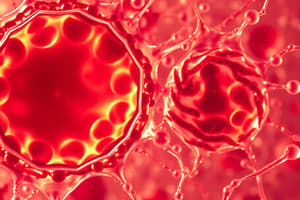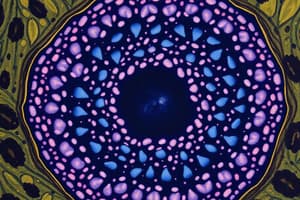Podcast
Questions and Answers
What is the main difference between prokaryotic and eukaryotic cells?
What is the main difference between prokaryotic and eukaryotic cells?
- The presence of a capsule
- The presence of a nucleus (correct)
- The ability to synthesize proteins
- Having a cell membrane
What is the primary function of ribosomes in a cell?
What is the primary function of ribosomes in a cell?
- Producing energy through cellular respiration
- Synthesizing proteins (correct)
- Transporting materials within the cell
- Storing and transmitting genetic information
Which of the following is NOT a characteristic of prokaryotic cells?
Which of the following is NOT a characteristic of prokaryotic cells?
- Presence of ribosomes
- Presence of a nucleus (correct)
- Presence of a cell wall
- Presence of a cell membrane
What is the main component of the cell wall in most prokaryotes?
What is the main component of the cell wall in most prokaryotes?
What is the primary function of a prokaryotic capsule?
What is the primary function of a prokaryotic capsule?
What is the function of pili in prokaryotes?
What is the function of pili in prokaryotes?
Which of the following is NOT a proponent of the cell theory?
Which of the following is NOT a proponent of the cell theory?
What is the difference between a micrograph and a photograph?
What is the difference between a micrograph and a photograph?
Flashcards
Cell
Cell
The smallest unit of a living organism, responsible for all life processes.
Microscope
Microscope
An instrument that magnifies small objects, allowing us to see cells.
Cell Theory
Cell Theory
A fundamental theory stating all living things consist of one or more cells, and new cells arise from existing cells.
Prokaryotic Cell
Prokaryotic Cell
Signup and view all the flashcards
Eukaryotic Cell
Eukaryotic Cell
Signup and view all the flashcards
Ribosome
Ribosome
Signup and view all the flashcards
Cell Membrane
Cell Membrane
Signup and view all the flashcards
Cytoplasm
Cytoplasm
Signup and view all the flashcards
Study Notes
Cytology - Part 1
- Cytology is the science that studies cells.
- Cells are the fundamental units of composition and function in living organisms.
- The cell is the smallest unit of a living organism.
- Anton van Leeuwenhoek invented the microscope in 1591.
- Microscopes are instruments that magnify objects.
- Micrographs are images created using a microscope.
- Cells are the basic building blocks of all organisms.
- Some organisms are unicellular (e.g., bacteria) and others are multicellular (e.g., humans).
- Cells vary in size.
- Cells are too small to be seen with the naked eye.
Cell Theory
- Proposed by Matthias Schleiden (botanist) and Theodor Schwann (zoologist).
- All living things are composed of one or more cells.
- The cell is the basic unit of life.
- New cells arise from existing cells.
Basic Structures of a Cell
- Plasma membrane: Separates the cell's interior from its surroundings.
- Cytoplasm: Jelly-like material within the cell.
- DNA: Genetic material of the cell.
- Ribosomes: Synthesize proteins.
Main Types of Cells
1. Prokaryotic Cells
- Simple cells.
- Examples: Bacteria and Archaea (mostly unicellular).
- Lack a nucleus and membrane-bound organelles.
- DNA is located in the nucleoid region.
- Contain small ribosomes (70s) scattered in the cytoplasm.
- Cell wall is often present and composed of peptidoglycans.
- May have flagella for locomotion.
- Small cells (0.3-5mm).
2. Eukaryotic Cells
- Complex cells.
- Examples: Animals, plants, fungi, and protists.
- Have a nucleus and membrane-bound organelles.
- Contain large ribosomes (80s) attached to the endoplasmic reticulum.
- Cell wall composed of cellulose in plants is present.
- May have flagella or cilia for movement.
- Larger cells (10-100mm).
Cell Wall
- Provides protection and helps maintain cell shape.
- Some cells have a capsule made of polysaccharide.
- The capsule enables the cell to attach to surfaces or in the environment.
- Some prokaryotic cells have flagella for movement.
- Some prokaryotic cells have pili for exchanging genetic material in a process called conjugation.
Studying That Suits You
Use AI to generate personalized quizzes and flashcards to suit your learning preferences.




